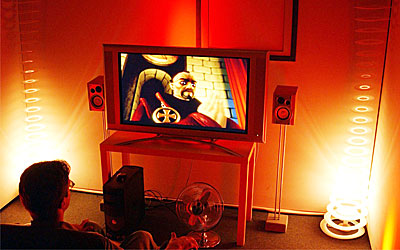amBX
Ambient intelligent environment extends the gaming world into the real world through the use of light, color, sound, and airflow
 In 2005, Philips amBX technology redefined the experience of playing video games, watching movies, and listening to music. Using light, color, sound, heat, and air, amBX submerged the user within a complete sensory surround experience, which extended the gaming world out of the screen and into the real world by barraging the senses with audio and visual queues tuned to the action on the screen. Philips talked with several leading game developers and peripheral manufacturers about amBX-enabling leading games and devices. The amBX technology was launched in May of that year, while amBX-enabled games and peripherals arrived near the end of the next.
In 2005, Philips amBX technology redefined the experience of playing video games, watching movies, and listening to music. Using light, color, sound, heat, and air, amBX submerged the user within a complete sensory surround experience, which extended the gaming world out of the screen and into the real world by barraging the senses with audio and visual queues tuned to the action on the screen. Philips talked with several leading game developers and peripheral manufacturers about amBX-enabling leading games and devices. The amBX technology was launched in May of that year, while amBX-enabled games and peripherals arrived near the end of the next.
"For video game creators, this is a fantastic opportunity as amBX expands the immersive experience by bringing gameplay into the real world environment," said Jo Cooke of Philips amBX. "The creative possibilities, using this technology, for the games industry and beyond are immense."
The result of extensive research and development, amBX delivers an all-new player experience through enabled devices including LED color-controlled lights, active furniture, fans, heaters, audio, and video -- strategically placed in the user's room. By utilizing this ground-breaking technology, journeys through the Amazon will turn rooms jungle green, swimming with dolphins will splash rooms deep blue, Halo jumps will turn fans on full, lightning storms will trigger strobe effects of white light and pirate ships on fire off the coast of treasure island will blast on heaters.
The amBX experience comes alive through the incorporation of a scripting language, software engine, and hardware architecture. Philips amBX provides the support framework for peripheral manufacturers to develop these enabled products and empowers game developers to amBX-enable and enhance their games. Through amBX, Philips has forged a common language for the creation, distribution, and sharing of new experiences within an ambient intelligent environment.
Sensory Feedback in Gaming
Today, sensory feedback in gaming has become an essential aspect of the immersive experience, providing players with tactile and sensory responses that correspond to on-screen actions. Here's a list of features and standards for sensory feedback in gaming:
- Haptic Feedback:
- Vibration and Force Feedback: Many controllers and devices provide vibrations or force feedback to simulate physical sensations.
- Texture Simulation: Advanced haptic technology can simulate the feel of different textures, enhancing realism.
- Motion Control: Some systems use motion controls with haptic feedback to provide a more intuitive and engaging experience.
- 3D Audio:
- Surround Sound: Multi-channel audio systems create a 3D sound environment, allowing players to perceive direction and distance.
- Dynamic Sound Adjustment: The audio changes in real-time based on the player's actions and the game environment.
- Visual Feedback:
- Dynamic Lighting: Changes in lighting correspond to in-game events, enhancing immersion.
- High Frame Rate: Smooth and responsive visual feedback is essential for a seamless gaming experience.
- Olfactory Feedback:
- Scent Technology: Some experimental systems have explored the use of scent to provide feedback related to the game's environment or actions.
- Thermal Feedback:
- Temperature Changes: Certain devices can simulate temperature changes, such as warmth or coolness, corresponding to in-game events.
- Standards and Compatibility:
- Cross-Platform Support: Sensory feedback features should be compatible across different platforms and devices.
- Accessibility: Consideration for players with disabilities, ensuring that sensory feedback does not hinder accessibility.
- Customization: Allowing players to adjust or disable sensory feedback according to their preferences.
- Health and Safety Considerations:
- Sensory Overload: Ensuring that sensory feedback does not lead to sensory overload or discomfort.
- Regulatory Compliance: Adhering to standards and regulations related to health and safety.
- Integration with Virtual Reality (VR) and Augmented Reality (AR):
- Full Immersion: VR and AR systems often incorporate advanced sensory feedback to provide a fully immersive experience.
- Realistic Interaction: Sensory feedback in VR and AR allows for more realistic and intuitive interactions with virtual objects.
- Quality Assurance and Testing:
- Ensuring that sensory feedback functions correctly and enhances the gaming experience without causing issues or distractions.
- Future Developments and Innovation:
- Continuous research and development to explore new ways of enhancing sensory feedback, such as integrating biometrics or creating more nuanced haptic sensations.
